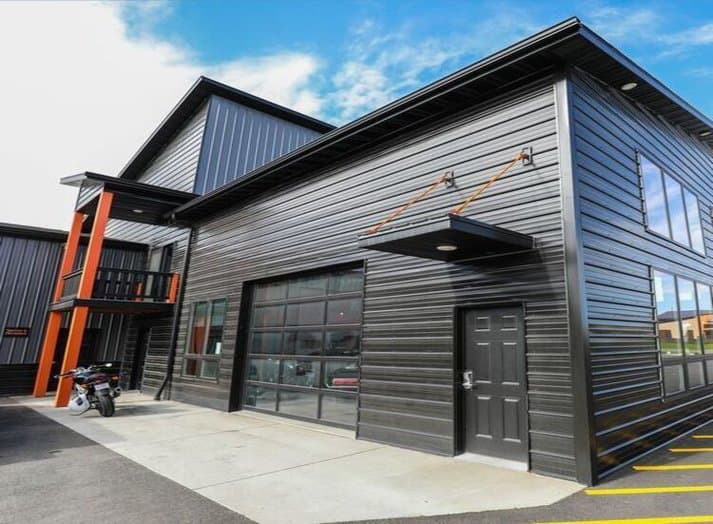In today’s world, there are many reasons why people might choose to become survivalists or preppers. Some people may be concerned about the possibility of a natural disaster, such as a hurricane, earthquake, or tornado. Others may be worried about the possibility of a man-made disaster, such as a terrorist attack or nuclear war. Still others may simply want to be prepared for any unexpected event that might disrupt their daily lives.
No matter what the reason, survivalists and preppers all have one thing in common: they need to have a place to store their supplies and shelter themselves from the elements. And when it comes to choosing a shelter, steel or metal buildings are the best option.
Why Steel or Metal Buildings?
There are many reasons why steel or metal buildings are the best choice for survivalists and preppers. First, they are incredibly strong and durable. Steel buildings can withstand high winds, heavy snow loads, and even earthquakes. This makes them ideal for storing food and supplies in any climate.
Second, steel buildings are relatively affordable. This is important for survivalists and preppers, who may be on a budget.
Third, steel buildings are easy to build. They can be assembled quickly and easily, even by people with no construction experience. This is important for survivalists and preppers, who may need to build a shelter quickly in an emergency situation.
Fourth, steel buildings are secure. They can be locked and equipped with security systems to protect your belongings from theft and vandalism. This is important for both survivalists and preppers, who need to keep their food and supplies safe.
Fifth, steel buildings are customizable. You can choose the size, shape, and features of your building to suit your unique requirements. This is important for survivalists and preppers, who may have specific needs for their food storage and shelter.
How to Use Steel or Metal Buildings for Survival
There are many different ways that steel or metal buildings can be used for survival. Here are a few examples:
- Food storage: Steel buildings can be used to store food for both short-term and long-term use. For short-term storage, steel buildings can be used to store canned goods, dry goods, and other non-perishable food items. For long-term storage, steel buildings can be used to store freeze-dried food, MREs, and other long-lasting food items.
- Shelter: Steel buildings can be used to build a variety of shelters, including cabins, garages, and barns. These shelters can be used to protect you from the elements and to provide a secure place to store your belongings.
- Workshop: Steel buildings can be used to build a workshop where you can repair and maintain your equipment. This is important for survivalists and preppers, who need to keep their equipment in good condition.
- Command center: Steel buildings can be used to build a command center where you can monitor the situation and coordinate your response in the event of a disaster.
- Safe room: Steel buildings can be used to build a safe room where you can shelter your family from dangerous weather or other threats.
Tips for Choosing a Steel or Metal Building for Survival
When choosing a steel or metal building for survival, there are a few things you should keep in mind:
- Size: Choose a building that is the right size for your needs. If you are planning to store a lot of food and supplies, you will need a larger building. If you are just planning to use the building for shelter, you can choose a smaller building.
- Shape: Steel buildings can be made in a variety of shapes, including rectangular, square, and hexagonal. Choose a shape that will work best for your needs and the space you have available.
- Features: Steel buildings can be customized with a variety of features, such as windows, doors, and vents. Choose the features that are important to you.
- Price: Steel buildings can vary in price depending on the size, shape, and features you choose. Set a budget before you start shopping and compare prices from different suppliers.
Conclusion
Steel or metal buildings are the best option for survivalists and preppers. They are strong, durable, affordable, easy to build, secure, and customizable. If you are serious about being prepared for any eventuality, you should consider investing in a steel or metal building.
Here are some additional benefits of using steel or metal buildings for survival:
- Pest control: Steel buildings are resistant to pests such as termites and rodents. This is important for survivalists and preppers, who need to keep their food and supplies safe from pests.
- Fire resistance: Steel buildings are fire resistant. This is important for survivalists and preppers, who need to protect their belongings from fire.
- Longevity: Steel buildings can
Survivalist FAQs Regarding Shelter
Q: What is the best type of shelter for survivalists?
A: The best type of shelter for survivalists is one that is strong, durable, and secure. Steel or metal buildings are a good choice because they are able to withstand high winds, heavy snow loads, and even earthquakes. They are also relatively affordable and easy to build.
Q: What are some other types of shelters that survivalists can use?
A: Other types of shelters that survivalists can use include:
- Tents: Tents are a good option for short-term survival situations. They are lightweight and easy to transport, but they are not as durable as other types of shelters.
- Tarps: Tarps can be used to create a variety of shelters, such as lean-tos and A-frames. They are also lightweight and easy to transport, but they are not as durable as other types of shelters.
- Caves: Caves can provide good shelter from the elements, but they can also be dangerous due to hazards such as rockfalls and wild animals.
- Underground bunkers: Underground bunkers are the most secure type of shelter, but they are also the most expensive and difficult to build.
Q: What are some important things to consider when choosing a shelter location?
A: When choosing a shelter location, it is important to consider the following factors:
- Proximity to water: It is important to have access to water for drinking, cooking, and bathing.
- Proximity to food: It is also important to have access to food sources.
- Security: Choose a location that is well-hidden and difficult to access.
- Drainage: Choose a location that is well-drained to avoid flooding.
- Accessibility: Choose a location that is accessible even in bad weather conditions.
Q: What are some things I need to do to prepare my shelter for survival?
A: Once you have chosen a shelter location, you need to prepare your shelter for survival. This includes:
- Stocking your shelter with food and water: It is important to have enough food and water to last you for at least two weeks.
- Insulating your shelter: It is important to insulate your shelter to keep you warm in the winter and cool in the summer.
- Ventilating your shelter: It is also important to ventilate your shelter to prevent the buildup of moisture and mold.
- Securing your shelter: Make sure your shelter is well-secured to protect it from intruders and wild animals.
Q: What are some additional tips for surviving in a shelter?
A: Here are some additional tips for surviving in a shelter:
- Stay calm and positive: It is important to stay calm and positive in a survival situation. This will help you to think clearly and make good decisions.
- Conserve your energy: It is important to conserve your energy in a survival situation. This means avoiding unnecessary activity and eating a healthy diet.
- Be aware of your surroundings: It is important to be aware of your surroundings in a survival situation. This means being on the lookout for potential hazards and opportunities.
- Have a backup plan: It is important to have a backup plan in case your shelter is damaged or destroyed. This could include having a secondary shelter location or having a way to signal for help.
By following these tips, you can increase your chances of surviving in a shelter.



Recent Comments